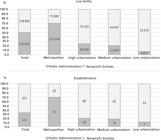Abstract
Objectives:
to analyze the relation between cesarean section rates in SUS childbirth care establishments in São Paulo State and urbanization conditions, according to Robson group classification system.
Methods:
Sistema de Informação sobre Nascidos Vivos (Live Births Information System) and Cadastro Nacional de Estabelecimentos de Saúde (National Registry of Health Establishments) 2016 databases were analyzed. The studied outcome was cesarean section rates in the establishments, grouped by administration type (public or nonprofit entities) and urbanization condition.
Results:
the cesarean section rate in SUS childbirth care establishments was 50.5%, ranging from 41.1% in metropolitan regions up to 75.2% in the low urbanized regions. Cesarean section rates in public administration establishments (38.2%) were significantly lower than the nonprofit administration maternity hospitals (62.3%). Robson groups 5 and 2 contributed mostly to the cesarean section global rate (36.6% and 21.5%, respectively).
Conclusions:
The less urbanized regions showed significantly higher cesarean section rates than the metropolitan and highly urbanized regions. Cesarean section rates of public administration establishments were significantly lower than the nonprofit administration establishments. However, when separated by urbanization condition its difference was only observed in the metropolitan regions.
Key words
Cesarean section; Childbirth; Regionalization; Urbanization; Public health system

 Thumbnail
Thumbnail
 Thumbnail
Thumbnail

